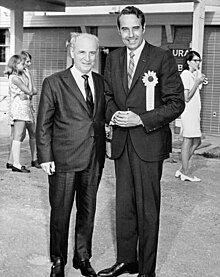Hampar Kelikian
Hampar Kelikian | |
|---|---|
 Dr. Kelikian and Bob Dole posing for a picture | |
| Born | January 17, 1899 |
| Died | July 24, 1983 (aged 84) |
| Nationality | United States |
| Occupation | Orthopedic Surgeon |
Hampar Kelikian (January 17, 1899 – July 24, 1983) was a pioneering orthopedic surgeon, who significantly extended the surgical field.[1][2]
Being a pioneer in the surgical restoration of otherwise useless limbs,[3] he was instrumental in helping U.S. Senator Bob Dole. When Dole returned from World War II with injuries that had left his right arm useless and about to be amputated, Kelikian fixed the shattered shoulder and allowed Dole to regain some use of his arm.
Biography
Kelikian was an Armenian orthopedic surgeon and native of Hadjin in the Ottoman Empire. He came to America in 1919 to escape the Armenian Genocide, an event during which his three sisters had been killed.[4] He was inspired to become a surgeon by his uncle, who worked as a surgeon in the Ottoman army. After emigrating to the United States in 1920, Kelikian worked as a waiter at the University of Chicago, and then obtained a scholarship to train there and at Rush Medical College, as he turned out to be bright and talented. He performed his internship at Cook County Hospital, and in 1929 became an assistant to Philip Kreuscher, who had been in practice with the bone specialist John B. Murphy.
During World War II, Kelikian served as chief orthopedic surgeon and lieutenant colonel at the 297th General Hospital. Bob Dole was one of his many patients, and Kelikian refused to accept any fees from the young veteran, since his brother Siragan had been killed in Italy in 1943. In total, Kelikian performed seven operations between 1947 and 1953 to restore the use of Dole's arm by transplanting leg bone and muscle to the right shoulder and hand. Kelikian is also credited with saving the left arm of a young Victor A. Lundy, who would later become a famous architect in the 1950s and 1960s. When Kelikian returned to Chicago, he joined the staff of Wesley Hospital and Northwestern Medical School.
Kelikian later became an emeritus associate professor of orthopedic surgery, performing ten operations a week when he was 80. Kelikian wrote three monographs on hand, ankle, and foot surgery, as well as a book on Armenian poetry. He also specialized in congenital deformities, particularly gigantism. He never charged Armenians for treatment.[2]
Kelikian had a son Armen, also a surgeon, and two daughters, Alice and Virginia, by his wife Ovsanna. He died on Sunday July 24, 1983 at Northwestern Memorial Hospital in Chicago. He was 84.
Achievements
While he was working for the United States Army, his services were recognized by President Harry Truman, who gave him a citation and a medal. He was also received a citation from the Queen while working as a consulting orthopaedic surgeon at the Ronkswood General Hospital in Worcester.[citation needed] In 1969, he was appointed to President Nixon’s Task Force for the Disabled. In 1966 he was invited to visit Lebanon by Pr. Emile Riachi and was awarded the Order of the National Cedars of Lebanon by president Charles Helou[5]
References
- ^ http://www.ejbjs.org/cgi/reprint/66/4/632.pdf
- ^ a b Breu, Giovanna (8 October 1979). "Dr. Hampar Kelikian Is a Dear and Glorious Surgeon and, at 80, Still Among the Best". People Magazine. 12 (15).
- ^ http://www.abrilbooks.com/books/2545.html
- ^ Power, Samantha (2013). A Problem From Hell America and the Age of Genocide. New York: Basic Books. ISBN 0465050891.
- ^ http://www.ejbjs.org/cgi/reprint/66/4/632.pdf
External links
- 1899 births
- 1983 deaths
- American physicians
- Ethnic Armenian physicians
- American people of Armenian descent
- Ottoman Armenians
- Rush University alumni
- University of Chicago alumni
- Ottoman emigrants to the United States
- Northwestern University faculty
- Recipients of the National Order of the Cedar
- Armenian Genocide survivors
- American military personnel of Armenian descent
